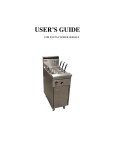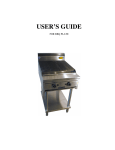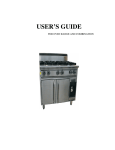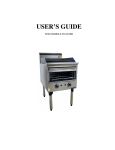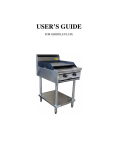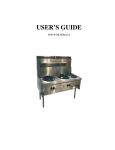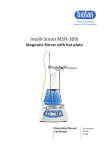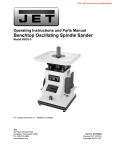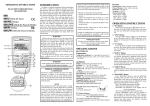Download USER'S GUIDE - Crawford Kitchens
Transcript
USER’S GUIDE FOR DEEP FRYER SPECIFICATION NAME OF APPLIANCE SUPERTRON COMMERCIAL DEEP FRYER MOFRL NO. DF-400, DF-800, DF-1200 MANUFACTURED BY TU’S BROS PTY LTD 77 MAIN ROAD, CLAYTON SOUTH VIC 3169 AUSTRALIA 6139 CERTIFICATE NO. General Description Heavy Duty Commercial Deep Fat Fryer manufactured in stainless steel outer panels with stainless steel pan, in single, double or triple units. Heating of the unit is by means of duck bill burners mounted on a cast ‘U’ shape manifold. The burner is located beneath the fry pan. The fryer has a deep cool zone and comes equipped with complete flame failure and over temperature cut out. The temperature of the oil is thermostatically controlled. The splashback incorporates the flue system from the combustion chamber. The flue outlet at the top of splashback deflects the products of combustion from the rear walls. The outer panels are attached to a square sub frame which is rust proofed. Exterior Panels 304-N4x1.2mm stainless steel Sub Frame Fry Pan Rear Panel Insulation Heating of Unit 20x20x1.2 square tube 2.0mm stainless steel 1.2mm aluminised steel Fibre Millboard incapsulated within a metal casing Is by means of individual duck bill burners. The burners are mounted onto a cast ‘U’ form manifold 40mmx40mmx3mm Square section. Overall length 405mmx160mm centres. Duck Bill 45mm centres. Number of Duck Bill Burners 16 x 1.05mm orifice N.G. 16 x 0.65mm orifice LPG Primary Aeration Fixed Ø6mmx8mm up from should of thread. Burner Supports Vessel Clearance Fluing Provided by 25mmx25mm angle iron welded to main frame. Highest sloping point of pan from top of cast manifold 300mm 2x70x70 holes from combustion chamber into a rectangular vertical rising flue 50mmx300mm Overall Dimensions Height over splashback Width 1130mm 400mm (DF-400), 800mm (DF-800), 1200mm (DF-1200) Depth (front to back) Working Height Leg Height Gas Inlet 790mm 900mm 150mm A ¾" B.S.P connection is provided for each pan. 276mm above floor x 90mm from left hand side Gas Regulator Thermostat Within Nova 820 M.V. Combination Control S.I.T. Nova 820 M.V. thermostatically operated combination control Approval No. 4032. In circuit with Robert Shaw LCCM operation switch. Thermostat E.G.O. Model 55/130/42 Range 230-205, Approval No. 4270. Robert Shaw Model LCCM 5525-028 Approval No.2263 Hi Limit Over Temperature Cut Out Oil Drain Valve 1" B.S.P (25mm) Depth of Cool Well 270mm Width of Cool Well 92mm Operating Oil Level from Top of Pan Thermostat Capillary Location 80mm (Bulb) 210mm from top of pan ledge x 50mm centres Hi Limit Capillary Location (Bulb) 210mm from top of pan ledge x 50mm centres 2 Burner Location Fry Pan Dimensions Front to Back Depth Width 400mm above floor Nominal Hourly Gas Consumption NG: 90MJ per Pan LPG: 85MJ per Pan Test Point Pressure NG: 1 KPa LPG: 2.75 KPa Flue size From combustion chamber vertical riser into splashback outlet 420mm x50mm 250mm (H) x 90mm (W) Hi Tension Spark Igniter incorporated within the thermostat. Pilot light mounted adjacent to the left front duck bill burner with a fast cut out thermocouple in conjunction with the flame failure control Is by means of a 1.2mm aluminized heat shield mounted off the base angle iron frame 100mm high x 400mm wide x 460mm front to back. Located against flue end of appliance. Splashback Burner Ignition By Floor Protection 534mm 510mm 405mm (DF-400), 805mm (DF-800), 1205mm (DF-1200) INSTALLATION INSTRUCTIONS (By Authotised Personnel Only) Gas point entry is 276mm above floor and located at the left side of the unit. A 20mm 3/4" BSP regulator is supplied with each pan. The installer is to supply and fit an isolating gas cock to the appliance for ease of servicing the control system. N.B. Double and Triple units have separate inlet to each control and must have a separate gas cock. The installer must install the appliance to AG601, 1995 Sections 5-12-4.5 and in accordance with local gas and water regulations. Clearances form combustible walls sides – left and right 50mm. Rear wall 50mm and must be installed on a fire proof base. Unit may be installed against fire proof walls. Refer installer instructions for special instructions for this type of installation. ADDENDA “The installer must install the appliance to AG601, 1995 Section 5.12.4 and in accordance to local regulations, attention must be give to Section 5.12.4.4 and 5.12.4.5. 5.12.4.6 Commercial catering equipment on combustible surface, where equipment is installed on a combustible surface it shall be protected by fire resistant material. Fire resistant material specifications where appliances are to be installed in non combustible area, the installer must refer to AG601 and ensure the following side walls and bare walls have materials to the specifications referring to standards A-S 1530.1 to be deemed not combustible and A-S 1530.3 have a zero (0) index for all of the following: 1. 2. 3. 4. Ignitability Spread of flame Heat evolved Smoke developed N.B. The thermal resistance not less than 0.05 M20 c/w but in no instance shall the material be of a thickness less than 6mm.” All models have a 20mm 3/4" BSP socket gas point or compression inlet. The appliance must be installed as set out in the specifications i.e. Natural gas operating test point pressure 1 KPa. Before leaving installation, check all gas and water fittings for leaks, and instruct operator in lighting and use of appliance. N.B. This appliance must always be mounted on 320mm legs as supplied. 3 If unit fails to operate, please contact local distributor or call manufacturer on Phone: (613) 9543 9577 Fax: (613) 9544 1487. OPERATING AND MAINTENANCE INSTRUCTIONS, SERVICE Deep fryer pan features a centre cool zone and crumb trap. A drain-off valve is provided. Heating of the fryer is by means of duck bill burners of high quality material with ports drawing in secondary air through the centre. The unit incorporates complete flame failure, safety and temperature control by a thermostat operation. A manual reset over temperature device is provided mounted on the frame adjacent to the burner, that should the thermostat fail, the gas is automatically turned off to the pilot system. Lighting Procedure for NG & LPG Units: 1. Interior of pan to contain enough oil to cover the thermostat bulb, to prevent overheating on burner ignition. 2. Turn thermostat to the OFF position. 3. Open main gas cock. 4. Press the top push button in (marked with a red flame embossing) and light pilot head adjacent to the burner. Note: On new installations this procedure may need to be repeated 2 or 3 times to allow dispersing of air trapped in gas line to unit. Normal time - approx. 15 seconds. 5. Release press button and turn thermostat dial to the maximum position for fast heat up, and then back to the temperature required. 6. The main burner can now be turned either completely on or off by means of the thermostat knob. Note: 7. Pilot burner will not be affected. If piezo lighting is not working, manual lighting can be used. Turning OFF Procedure: 1. Press push button in, (lower button marked in white), this closes the gas-way to the burner and also closes off the gas-way to the pilot. 2. The gas-way remains locked down by means of an Interlock device. It is now impossible to re-ignite the burner until the push button has returned to its original position. Thermostat Operation The thermostat is adjusted so that when the temperature of the frying oil reaches the thermostat dial setting the burner shuts off automatically and comes on again upon cooling of the frying oil, to maintain the temperature required. Note: For normal operation the thermostat dial can be used for the ON or OFF of the gas supply to the burner. Turn off at gas cock on appliance when appliance not required for use for long periods. Pan Draining A drain valve is located at the base of the cool zone and opening and closing of the valve is by means of a handle located on the front of the units, behind access door. 4 SERVICE (Must only be carried out by Authorised Personnel) Thermostat Re-Calibration – for NG & LPG 1. Set temperature to 1490C. 2. Remove thermostat dial from control by simply pulling forward. 3. Remove lock-nut and bush locating washer. 4. Remove bush. 5. By watching carefully the temperature rise of the oil with the thermostat, turn the control off by means of gripping the splined spindle when the temperature is approximately 100C under1490C. Note: This allows for a slight latent heat rise after the burner is shut off. 6. Place some grease into the serrated internal edge of the bush for adhesion purposes, then fit the bush into the thermostat dial. 7. Push the dial and bush over the splined spindle firmly, ensuring that the 1490C mark lines up with the reference pointer on the thermostat case. When this is done remove the dial and the bush should remain in position by means of grease. All that remains now is to replace the bush locating washer and lock-nut and replace the dial. Removal of Thermostat Cover Pilot regulating screw is located under the control cover as well as a flame rate adjuster if required. This is normally set at the factory; however, if it becomes necessary to remove the cover, the following steps are required: 1. Set dial to the OFF Position. 2. Remove thermostat dial by pulling forward. 3. Unscrew the two screws and remove the cover. Make sure that the stop does not catch against the lower plate; it is to avoid this that operation (1) is necessary. On units it may be necessary to remove a button cover off the control first. DIAGRAM 5





